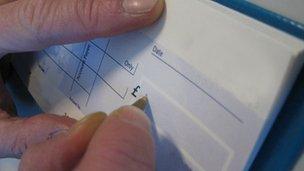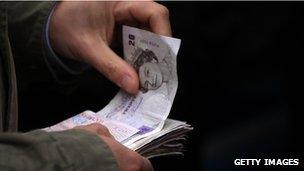Shopping around for a bank account
- Published

Many customers remain with their current account provider for many years
Following a speech last week by the future banking regulator, Andrew Bailey, there has been speculation about the possible end of free-in-credit current accounts.
Most people have got used to not having to pay for their current account, unless they go overdrawn. The UK is unique in Europe in enjoying free banking so its demise would cause quite a stir.
One of the features of the current account market is that customers tend to be very loyal. Only about 4% to 8% of customers switch their current account each year, depending upon which estimate you read.
But are they paying for such loyalty? It is quite possible that by changing their current accounts, they could get a better deal elsewhere.
It is also likely that switching would increase dramatically if free-in-credit current accounts disappeared because the imposition of monthly charges would undoubtedly spur many to look for possible alternatives.
In essence, there are four types of current account available.
Basic bank accounts
These do not offer overdrafts. If they have a debit card it tends to have limited facilities.
They can be opened without undergoing any credit check and are offered by the providers as part of the government's strategy for financial inclusion because they enable those who cannot get a full service current account to access banking facilities.
They do not incur a monthly fee. There are 20 basic bank accounts available.
Free-in-credit current accounts
These are full-service bank accounts that are free to use for those that remain in credit. There are 55 free-in-credit current accounts available.
Student current accounts
These are broadly similar to free-in-credit current accounts but tend to offer interest free overdrafts and other goodies to attract students who, the providers hope, will remain long-term customers.
There are 28 student current accounts available.
Packaged current accounts
These are full service current accounts that charge a monthly fee which typically range from about £8 up to £25, although some premier accounts charge as much as £40.
In exchange for the charge, a variety of incentives such as travel insurance, mobile phone insurance and motor breakdown assistance policies are provided.
There are 65 <link> <caption>packaged current accounts</caption> <url href="http://www.bbc.co.uk/news/business-16596949" platform="highweb"/> </link> available.
There are also a number of current accounts denominated in foreign currencies which can be useful for those who have foreign income and expenditure.
Providers
Current accounts tend to be dominated by the banks but there are five building societies that offer current accounts.
There are also a number of foreign banks that offer them such as ICICI, Punjab National Bank and the State Bank of India. Tesco has signalled its intention to launch a current account in the not-too-distant future.
When looking for a new current account, there are a few key points to consider.
Firstly it depends upon how the account will be used, because the best account will vary from person to person.
Those who never use an overdraft should opt for an account that pays interest on credit balances. Some 63% of current accounts no longer pay interest.
Examples include Halifax's Reward Current Account, which pays £5 (net of basic rate tax) every month that at least £1,000 is paid in. Santander's 123 Current Account charges £2 a month but pays interest of 1% on balances over £1,000, 2% on the entire balance if the balance is over £2,000, or 3% on the entire balance if it is over £3,000 up to a maximum balance of £20,000. It also pays cash back on council tax, utility and communications bills.
Somebody more likely to go overdrawn should concentrate on the overdraft costs. There are a myriad of different overdraft tariffs in the market and this complexity makes overdraft comparisons very difficult.
The size and frequency of overdraft usage and the number and size of transactions can all affect the overall cost. It is also worth noting that the availability of overdrafts is subject to the credit status of the applicant.
Some current accounts offer an ongoing interest-free overdraft. The highest interest free overdraft from a free-in-credit current account is £500 from Citibank's Plus Current Account but customers must pay at least £1,800 into the account every month otherwise there is an £8 monthly fee. By paying less than £1,250, the interest free overdraft is removed.
It is worth noting that interest-free overdrafts are generally more prevalent among packaged current accounts.
Online banking
Customers should also consider whether they want branch access or would accept doing all their banking online. They should check that the account permits them to operate it as they wish.

Switching bank accounts can save customers money, according to David Black
Some accounts insist on paying in a minimum monthly amount every month - typically £500, £750, £1,000 or £1,500. This is to ensure it is used as a primary current account.
Failing to pay in the required monthly amount with one of these accounts would probably lead to a benefit or incentive being reduced or removed, or a financial penalty being levied.
Anyone contemplating a packaged current account should make sure they want and need the various incentives and, if so, that they are suitable for their circumstances and represent value for the monthly fee being charged.
Some providers restrict certain other products to their current account customers. Anyone wanting an HSBC credit card or unsecured loan can only get it if they have an HSBC current account. NatWest and RBS have a similar restriction.
Some providers offer special mortgage deals to their current account customers, but do bear in mind that just because a mortgage is a "special" deal, it does not necessarily mean that it cannot be beaten elsewhere.
Enhanced savings, unsecured loan and credit card deals are similarly in evidence.
There is no doubt that providers want you as a current account customer, provided of course that you use it as your main current account.
They regard it as the key way to build a relationship with the customer and it enables them to target customers with other products that are appropriate for their circumstances.
Many providers want to become a one-stop shop for all their customers' financial needs, and the current account is the preferred avenue by which to deepen such relationships.
A current account does not have to be for life and there are significant safeguards being put in place to make switching a relatively seamless process. It is worth taking the time to see if you can get a better deal and it might save you a lot of money.
<italic>The opinions expressed are those of the author and are not held by the BBC unless specifically stated. The material is for general information only and does not constitute investment, tax, legal or other form of advice. You should not rely on this information to make (or refrain from making) any decisions. Links to external sites are for information only and do not constitute endorsement. Always obtain independent professional advice for your own particular situation.</italic>